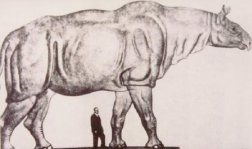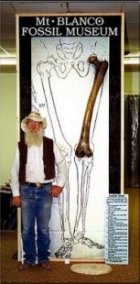


The Puzzle of Prehistoric Mega Fauna
Did you ever go to a natural history museum when you were young and marvel at the massive dinosaur skeletons on display? Those towering giants made a very big impression upon me when I was six. I bought the books, had the plastic toy. However, one question I never seriously asked, was why no earth are so many of the animals preserved in the fossil record vastly larger than the modern day descendents? This is not a question of small fast mammals out competing big slow dinosaurs in a nuclear-winter type environment caused by a massive asteroid collision. The fact of the matter is as I state on my main page, historical rhinos were 20 feet tall, ancient men were 16 feet tall, cockroaches were 2 feet long, etc, etc, etc. The fossil world demonstrates that all prehistoric life just existed on a different scale. Period. So while interesting, exactly what is the problem with all this?
The Bombshell
Let me explain the problem by reference to birds. Firstly you need to know how a wing works and what makes planes fly. Do not worry, this is not at all difficult. The top part of a wing is curved, and the bottom part is flat. This means that when air arrives at the front edge of the wing, the air going over the top has to go further to get to the rear edge of the wing. Because the air has to go further in the same time - it must move faster. Because it is moving faster it is more spread out and less dense. Therefore air pressure above the wing is lower than below the wing. The wing is therefore 'pulled,' up, into this area of low pressure. Simple. Right. Now the lifting ability of a wing depends upon surface area and increases with the square. This is only two numbers are involved, width and length. However, the mass or weight of a bird depends upon three factors, width, length, and depth. So mass increases with the cube. Hence at some point as birds grow larger, because mass increases faster than surface area, beyond a certain weight flight becomes impossible for birds. In the modern word, this is around 30 pounds. If that number does not mean much to you, think of a Swan or other such large bird. I've seen Swans in parks, beyond all question they can barely get off the water. Now, the problem is in the fossil record we have not 50 pound birds, but 200 pound birds. We can see there is simply no way these massive 200 pound birds could ever get off their bellies in the modern world. And if you are wondering how passenger jets get off the ground given what I have just said - the answer is they use a vastly more powerful power unit called a jet engine, which drives the air over the wings much faster than any flapping motion ever could, vastly increasing the lift potential of the wings.
Similar calculations can be made for land animals using muscle power to weight calculation - in effect elephants are the heaviest land animal that can exist in the modern world. Even assuming dinosaurs has muscles stronger than world record holding weight lifters does not get may dinos off their bellies. I'll add some calculations here later to demonstrate this.
My Point Being
The data provided by thousands of fossils pints to only one conclusion - something was different about early earth that enabled organisms as a matter of routine to grow to sizes that are physically and mathematically impossible in the modern world. How could this be? Well, even convention textbooks admit CO2 levels were vastly higher in early Earth, as were oxygen levels, however, it is hard to avoid the conclusion that something else in addition was different as well, and the most obvious candidate is gravity.
What's Wrong with Saying Gravity Was Weaker?
A lot. It has me totally baffled. Gravity is a function of mass. The heavier something is, the greater its gravitation field. I do not see there as being any question about Newton's laws of motion here. I'm happy with them. I believe they are correct at sub light speeds. So, obviously, at first glance, weaker prehistoric gravity suggests the earth was much smaller in the past than it was today, that is with less mass, and not just physically smaller.
If you want to know my take on all this, I think the earth accretes mass from space debris.
Expanding Earth Links
Flash slide
presentation
Dinosaurs and the expanding
Earth
http://www.expanding-earth.org/ -
Best site
Expanding
earth and tectonics
http://www.wincom.net/earthexp/
http://www.johnkharms.com/planetary.htm
Also be thankful that the huge bird on the right can not fly due to today's stronger gravitational field. Otherwise no-one would ever dare go out of the house! Just look at it .... jeeesh.
Talkorigins.org has a faq on megafauna. They come up with some half baked ideas to try and refute the gravity theory without ever really landing killer blows. Most glaring of all they do not try to explain how 200 pound birds could fly. I appreciate you can argue Sauropods spent all day in the water - but you can not really argue birds flew in the water. Basically all the questions the faq tries to answer are valid, and the experts have no real solution other than to stick their heads in the sand, start shouting 'la-la-la-la-la,' and pretend they can not hear you.
| Odds and Ends |
|---|
In contrast to standard evolution sites which do their best to convince you we know everything about evolution, the purpose of this web site is the opposite. I am just trying to convince you we do not have all the answers. Another of the many puzzles in the fossil record that few academics today wish to talk about is mega fauna. I have written a sub page to deal with the whole issue of mega fauna and the surrounding issues. The problems raised are never going to get solved until people admit they exist and start talking about them. However problematic, there must be a perfectly rational explanation here somewhere, even if it is a catastrophic one.
'In the late 1950’s, during road construction in the Euphrates Valley of south-east Turkey, many tombs containing the remains of giants were uncovered. At the sites the leg bones were measured to be 120 cms (47.24 inches). Joe Taylor, Director of Mt. Blanco Fossil Museum, was commissioned to sculpt the human femur. This giant stood some 14-16 ft tall (right). In his book Fossils Facts & Fantasies, Joe Taylor cites several accounts of giant human skeletons or depictions being discovered, from Egypt, Italy, Patagonia in Argentina, and the western US. The largest humans in recent history are like Robert Wadlow of Alton, IL who was just under 9ft tall .'
'Fossil ferns have been discovered the size of trees and horsetails once shot up over thirty feet tall. There were cockroaches about two feet long, as well as crickets, grasshoppers and monstrous spiders that thrived in a land of endless summer. Dragonflies with a three foot wingspan skimmed over swamps in which eight-foot beavers and sixty-foot cattails flourished. Beetles once grew to be the size of a baseball mitt and climbed up conifers that towered a hundred feet high. The fossil record is replete with examples of immense creatures that flourished in the past. Huge rodents like the giant guinea pig grew as big as a modern rhinoceros while the ancient rhino grew as big as a two-story building. (Note the 18 feet tall rhino from the University of Nebraska Museum.)' Link



:- I don't accept this idea, but this is my odds and ends page, see below links for various reasons why I reject this idea
THE FIRST
FOSSIL HUNTERS
ADRIENNE
MAYOR
Greek Myths: Not
Necessarily Mythical
* Ager,D.V. (1986) "Migrating fossils, moving plates and an expanding earth" Mdern Geology 10, 377-390
* Burk,K., and Dewey,J.F.(1974) "Two plates in Africa during the Cretaceous?" Nature 249, 313-316 (offers a conventional explanation for the triangular gap that remains between South America and Africa, when both plates are brought in contact; see also Vink).
* Carey,S.W. (1976) "The expanding Earth" New York: Alsevier Scientific Publishing Co (Contains a very extensive bibliography).
* Carey, S.W. (editor) (1983) "The expanding Earth: a symposium" Hobart, Tasmania: Department of Geology (for a review, see Systematic Zoology, 34, 103-104)
* Carey, S.W. (1988) "Theories of the Earth and Universe. A history of dogma in earth sciences" Stanford: Stanford University Press
* Carey, S.W. (1996) "Earth, Universe, Cosmos" Produced and distributed by Geology Department, University of tasmania. GPO Box 252-79 Hobart, Tasmania, Australia 7001
* Chdinov, Yu.V. (1998) "Global eduction tectonics of expanding earth" Zeist (The Netherlands): VSP
* Davidson, J.K. (1997) "Synchronous compressional pulses in extensional basins" Marine and Petroleum Geology 14(5), 513-549 (presents evidence for pulsed changes in curvature of the Earth's surface. From the Campanian to Recent, seven such pulses are identified)
* Maxlow,J. (1996) "Global expansion tectonics: small earth modelling of an expnentially expanding earth" Terrella Consultants, 29 Cecil Street, Glen Forrest, Western Australia, 6071.
* McKenzie,K.G. "Shallow Tethys 2. Proceedings of the international symposium of shallow Tethys 2. Wagga Wagga, 15-17 September 1986" Boston: A.A.Balkema (for review, see: Systematic Zoology,37, 311-312)
* Meservey, R.(1969) "Topological inconsistency of continental drift on the present-sized earth" Science 166, 609-611
* Owen, H.G. (1983) "Atlas of continental displacement, 200 million years to the present" Cambridge: Cambridge University Press (Compares fitting of the continents for expanding Earth with earth of constant diameter. Thetys, Paleoarctic Ocean and gore between South America and Africa on Earth of constant radius are presented as artefacts; all these gaps disappear when it is accepted, that the radius of the Earth was about 20% smaller during the lower Jurassic).
* Owen,H.G. (1990) "Of gaps and globes. Comments on the guest essay 'New geological theories and old biogeographical problems' by C.B.Cox(1990)J.Biogeogr.17,117-130" Journal of Biogeography 17, 693-695
* Owen, H.G. (1992) "Has the earth increased in size?" in: Chatterjee,S., and N.Hotton III (editors) "New concepts in global tectonics" Texas Tech University Press, Lubbock
* Owen,H.G. (1995) "Speculations on the physical state of the Earth's inner core". In: Barone,M. & Selleri,F. (editors) "Advances in Fundamental Physics" Palm Harbor(Florida): Hadronic Press, p.429-461
* Patterson,C., and Owen,H.G. (1991) "Indian isolation or contact? A response to briggs" Systematic Zoology 40, 96-100 (Assuming an earth of modern dimension, India was an island for much of its post-early Jurassic history. This seems at variance withthe absence of endimity, that is found for instance in South America and Australia. Owen's theory of an expanding earth allows for reduced isolation of India).
* Pickford,M. (1996) "Earth expansion, plate tectonics and Gaia's pulse" Bulletin du Muséum national d'histoire naturelle (Paris) 4e série.18, Section C, 451-516. A recent review of the subject.
* Rose, A.G. (1991) "La mobilité des continents. La tectonique des plaques et l'expansion de la terre" Publication de l'Association Francaise pour l'Avancement des sciences No 91, 3 (avril 1991) ISSN 0151-0304
* Shields,O. (1979) "Evidence for initial opening of the Pacific Ocean in the Jurassic" Palaeogeography, Palaeoclimatology, Palaeoecology 26, 181-220
* Shields,O. (1998) "Upper triassic pacific vicariance as a test of geological theories" Journal of Biogeography 25, 203-211
* Vink,G.E. (1982) "Continental rifting and the implications for plate tectonic reconstructions" Journal of geophysical Research 87, 10677-10688 (Offers an alternative explanation for the gore that remains between South America and Africa in conventional Pangaia reconstructions).
* Weijermars, R.(1989) "Global tectonics since the breakup of pangea 180 million years ago: evolution maps and lithospheric budget" Earth-Science Reviews 26, 113-162 (Against the expanding earth hypothesis. Comment of Owen 1990: "To arrive at the reconstruction given by Weijermars for Pangaea requires illegitimate stretching and distorsion of continental areas if a modern dimensions Earth is assumed. The only coincidence of the magnetic vector data both north and south with Antartica in its correct position in the proximity of the south polar region and the continental regions of the Artic covering the north polar region at the time of Pangaea occurs on an Earth of 80% of modern diameter at 180-200 Ma. This is a fact, however contentious this view might be").
A very interesting newsletter 'New Concepts in Global Tectonics' contains many articles discussing the Expanding Earth hypothesis. Subscription for individuals: US$30. Email: choiraax@u030.aone.net.au. Mail: 6 Mann Place, Higgins, ACT, 2615 Australia.
Have a look at this earth expansion site!
See also homepage of James Maxlow, who made his thesis on earth expansion.E-mail: jmaxlow@enternet.com.au
Homepage of Karl W.Luckert